Common menu bar links
Balance of international payments
Archived Content
Information identified as archived is provided for reference, research or recordkeeping purposes. It is not subject to the Government of Canada Web Standards and has not been altered or updated since it was archived. Please "contact us" to request a format other than those available.
Fourth quarter 2008
Balance of international payments note to readers
Highlights
The current account balance with the rest of the world (on a seasonally-adjusted basis) was a deficit of $7.5 billion in the fourth quarter of 2008, the first since the second quarter of 1999. The swing to deficit in the quarter was driven by a lower surplus for trade in goods. This primarily reflected the continued weakening of export volumes compounded by substantial declines in export commodity prices in the fourth quarter, especially pronounced for most energy products. Deterioration in the investment income deficit was also a contributing factor.
Chart D.1 First current account deficit since 1999
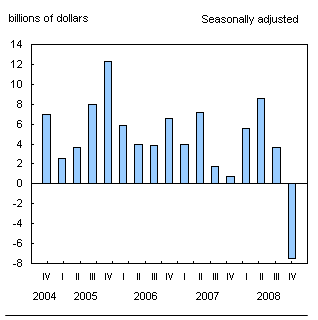
In the capital and financial account (unadjusted for seasonal variation), Canadians repatriated funds in the fourth quarter of 2008, as investors reduced their holdings of foreign securities by a record amount. Both inward and outward foreign direct investment activity was down, reflecting worldwide economic and credit conditions.
Current account
Lowest goods surplus in almost 15 years, as most energy prices decline sharply
In the fourth quarter of 2008, the goods surplus dropped $10.6 billion to $3.7 billion, its lowest level since the first quarter of 1994.
The value of goods exported fell $12.6 billion during the fourth quarter. This followed advances in the first three quarters that were supported by strong price gains (driven by energy) in the first half of the year, despite declining export volumes. The largest export declines in the quarter were in energy products (-26.6%) and were entirely due to much lower prices for most products, as volumes advanced.
Chart D.2 Export of energy products fall as prices drop significantly
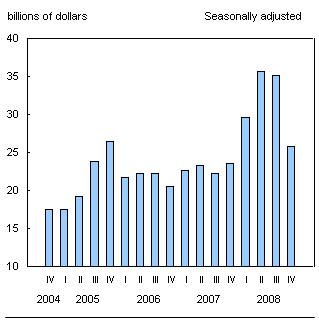
Industrial goods exports were down $4.0 billion through a combination of lower volumes and lower prices in the fourth quarter. The reduction in volume was widespread, with copper and nickel (including ores and alloys) registering the largest price reductions. Exports of automotive products resumed their downward trend. However, machinery and equipment exports improved further, led by higher prices for aircraft and for other machinery and equipment.
The value of imported goods fell back $2.0 billion in the fourth quarter, with energy prices also a major factor. Energy product imports declined (-16.7%), despite higher volumes. Imports of automotive products reached their lowest level in more than 10 years, with more than two thirds of the decline in passenger autos. Price increases led imports of machinery and equipment to a high, despite generally lower volumes.
Chart D.3 Goods surplus drops to a near 15-year low
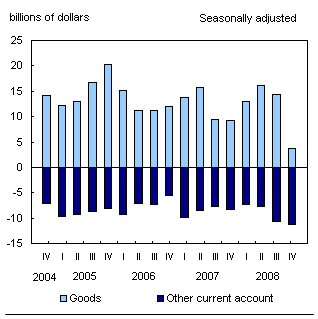
Investment income deficit widens on portfolio investment
The investment income deficit increased $0.8 billion in the fourth quarter of 2008, as portfolio investment receipts were down and portfolio investment payments were up. Lower holdings of and yields on foreign debt securities led to a $0.5 billion reduction in the interest received by Canadians. However, interest paid on Canadian bonds increased $0.4 billion. This increase was focussed in U.S. dollar-denominated corporate bonds and reflected the substantial depreciation (-14%) of the Canadian dollar vis-à-vis the U.S. dollar in the quarter.
Income from subsidiaries of both Canadian and foreign direct investors were down in the fourth quarter, in line with sagging corporate profits, especially in the energy sector.
Services deficit edges up, reflecting travel and commercial services activity
Larger commercial service payments, partially offset by higher travel receipts led to a slight increase in the services deficit during the fourth quarter.
As the Canadian dollar lost value against the U.S. dollar during the fourth quarter, spending by Canadian travellers fell for U.S. destinations but increased for overseas destinations. Both receipts from U.S. and overseas travellers improved slightly in the quarter, with more U.S. spending in Canada than in any other quarter of 2008.
Capital and financial account
Canadian investors shed foreign securities
In the context of turmoil in global financial markets and a sharp depreciation of the Canadian dollar, Canadian investors removed an unprecedented amount of foreign securities from their portfolios in the fourth quarter. This divestment reached $21.2 billion in debt and equity instruments, and marked the end of 29 years of net investment in foreign securities by Canadians.
Chart D.4 Marked divestment in foreign securities extends to equities as stock markets slump1
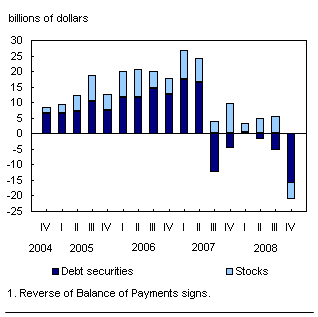
Canadians continued to reduce their holdings of foreign debt instruments over the fourth quarter, a trend that began in August of 2007. The fourth quarter of 2008 marked a divestment of $15.5 billion, largely foreign bonds. In addition, investors sold foreign equities in the quarter for the first time in nearly six years. Most of the divestment in foreign securities occurred in October when global stock markets recorded substantial losses. Canadian holdings of foreign equities were further reduced in the quarter by significant unrealized capital losses.
Canadian direct investment abroad weakens
Canadian direct investment abroad increased $11.6 billion. While relatively strong, this was about half the level of investment in the previous quarter. Takeover activity remained modest in the fourth quarter, with outflows mainly comprised of funds placed in existing foreign subsidiaries. Over 80% of the investment was directed to the U.S. economy, and nearly three-quarters in the energy and financial sectors. This capped a year of robust Canadian direct investment abroad.
Foreign direct investment in Canada also moderates
Foreign direct investment in Canada was at a similar level to Canadian direct investment abroad. Inflows slowed to $10.0 billion in the fourth quarter, as Canadian corporate earnings and equity values fell. Inflows were equally split between acquisitions and other flows. For a second straight quarter, foreign direct investment was concentrated in the Canadian energy and metallic mineral sector with investments of $6.3 billion as energy prices dropped significantly. Direct investment into Canada in 2008 was less than half of the level reached in 2007.
Chart D.5 Foreign direct investment in Canada down substantially in 2008 due to reduced foreign takeover activity
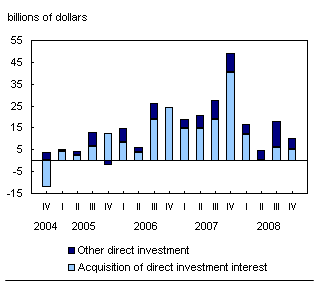
Non-residents adjust their portfolios of Canadian securities
Foreign investors removed $4.1 billion from their holdings of Canadian securities in the fourth quarter, in particular bonds. Divestment of $12.5 billion in Canadian bonds was the highest observed since the third quarter of 2003, and was attributable to retirements of federal and private corporate bonds.
Chart D.6 Foreign investors dispose of Canadian bonds in favour of more liquid investments
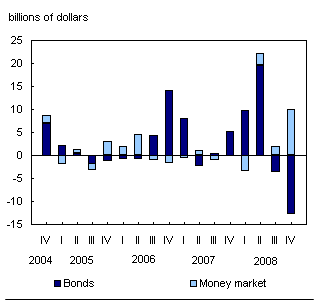
Non-residents adjusted their portfolios significantly in favour of more liquid investments in the Canadian money market, as the Canadian dollar depreciated and the differential on short-term rates between Canada and the U.S. moved substantially in favour of investment in Canada. Foreign purchases of Canadian short-term paper reached a high of $9.9 billion, mainly federal and federal enterprise issues. This may have also reflected the large supply of Canadian Treasury bills in the fourth quarter.
Year-end review 2008
Current account transactions
For 2008 as a whole, the current account surplus narrowed to $10.2 billion, down from $13.6 billion in 2007. This was led by a wider deficit on travel and, to a lesser extent, by a smaller goods surplus.
The value of the surplus on goods continued to shrink in 2008, as imports rose more than exports. The largest gains in exports were recorded in energy products due to higher prices, despite the price declines in the fourth quarter. Exports of industrial goods and agricultural products also improved as prices increased in 2008. Automotive products exports fell sharply during the year on notably lower volumes. Import increases were dominated by energy products as volumes and prices strengthened for the first three quarters of the year. Automotive products imports fell as volumes for trucks and for parts were down.
For a third consecutive year, the investment income deficit remained relatively low. The large drop in profits earned by Canadian direct investors was mostly offset by lower interest paid on banking positions.
The services deficit widened for the fourth straight year, mostly due to increased payments in travel services. While most of the 2007 increase in travel payments was coming through higher expenditures of Canadian travellers south of the border, the rise in 2008 was more evenly split between spending in United States and overseas destinations.
Capital and financial account transactions
The year 2008 marked the end of 29 years of net investment by Canadians in foreign securities. The divestment actually began in the second half of 2007, coinciding with the crisis in sub-prime mortgages situation in the U.S. which broadened credit market concerns. Canadian investors first reacted by disposing of significant amounts of foreign money market instruments in the last five months of 2007. This activity extended into foreign bonds in 2008 and subsequently into foreign equities after global stock markets collapsed in October 2008.
On the other hand, Canadian corporations' direct investment abroad was robust in 2008 at $80.3 billion, by far the largest annual outflow. The U.S. economy and the finance and insurance industry both received the bulk of the investment from Canadian direct investors in 2008, possibly a reflection of liquidity issues encountered by foreign affiliates in the face of the worldwide financial turmoil.
Foreign direct investment in Canada amounted to $49.0 billion in 2008, less that half the inflows for 2007. Foreign acquisitions in 2008 were down substantially after two years of strong activity which reflected increased global consolidation in the energy and metallic minerals sector. The deterioration of credit conditions in 2008 likely dampened this activity as did the word-wide equity market meltdown in October of 2008.
Despite a divestment in the second half of 2008, non-residents acquired a sizable $26.8 billion of Canadian marketable securities over the year, almost all in debt instruments. Acquisitions of long-term debt instruments dominated in the first half of the year while foreign investors turned to buy short-term paper in the second half, as the Canadian dollar slid and the short-term interest rate differential between Canada and the U.S. opened up in favour of investment in Canada. Foreign investment in Canadian stocks was moderate as prices experienced a 35% decline, concentrated in the last four months of the year.
Data tables
Information on methods and data quality available in the Integrated Meta Data Base: 1534, 1535 and 1536.

